The following is a list of the 100 largest cities in the Americas by city proper population using the most recent official estimate. [1] [2] [ circular reference ]
Contents

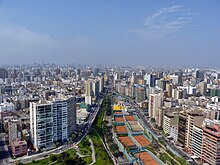








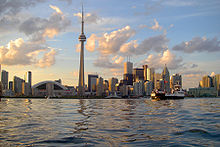

The following is a list of the 100 largest cities in the Americas by city proper population using the most recent official estimate. [1] [2] [ circular reference ]












Italics represents capital city
Bold represents largest city in country
| Rank | City | Country | Population | Population as of |
|---|---|---|---|---|
| 1 | São Paulo | 12,141,890 | 2023 | |
| 2 | Lima | 9,674,755 [note 1] | 2023 | |
| 3 | Mexico City | 9,209,944 [note 2] | 2023 | |
| 4 | New York | 8,398,748 | 2023 | |
| 5 | Bogotá | 8,064,000 | 2023 | |
| 6 | Rio de Janeiro | 6,718,900 | 2023 | |
| 7 | Santiago | 6,160,040 | 2023 | |
| 8 | Los Angeles | 3,990,456 | 2023 | |
| 9 | Buenos Aires | 3,072,029 | 2023 | |
| 10 | Brasília | 2,912,090 | 2023 | |
| 11 | Salvador | 2,871,560 | 2023 | |
| 12 | Toronto | 2,731,571 [note 3] | 2023 | |
| 13 | Chicago | 2,705,994 | 2023 | |
| 14 | Fortaleza | 2,669,340 | 2023 | |
| 15 | Santo Domingo | 2,581,827 | 2023 | |
| 16 | Belo Horizonte | 2,512,070 | 2023 | |
| 17 | Medellín | 2,480,000 | 2023 | |
| 18 | Cali | 2,383,500 | 2023 | |
| 19 | Houston | 2,325,502 | 2023 | |
| 20 | Guayaquil | 2,278,691 | 2023 | |
| 21 | Manaus | 2,171,700 | 2023 | |
| 22 | Havana | 2,131,480 | 2023 | |
| 23 | Caracas | 2,089,012 | 2023 | |
| 24 | Curitiba | 1,933,110 | 2023 | |
| 25 | Ecatepec | 1,837,700 | 2023 | |
| 26 | Maracaibo | 1,752,602 [note 4] | 2023 | |
| 27 | Montreal | 1,704,694 [note 5] | 2023 | |
| 28 | Phoenix | 1,660,272 | 2023 | |
| 29 | Recife | 1,645,730 | 2023 | |
| 30 | Quito | 1,607,734 | 2023 | |
| 31 | Philadelphia | 1,584,138 | 2023 | |
| 32 | Puebla | 1,544,500 | 2023 | |
| 33 | Guadalajara | 1,539,900 | 2023 | |
| 34 | San Antonio | 1,532,233 | 2023 | |
| 35 | Goiânia | 1,510,380 | 2023 | |
| 36 | Porto Alegre | 1,483,770 | 2023 | |
| 37 | Belém | 1,479,970 | 2023 | |
| 38 | Ciudad Juárez | 1,460,200 | 2023 | |
| 39 | Córdoba | 1,446,201 | 2023 | |
| 40 | Tijuana | 1,445,100 | 2023 | |
| 41 | Santa Cruz | 1,442,396 | 2023 | |
| 42 | San Diego | 1,425,976 | 2023 | |
| 43 | Guarulhos | 1,379,180 | 2023 | |
| 44 | Dallas | 1,345,047 | 2023 | |
| 45 | Montevideo | 1,304,687 | 2023 | |
| 46 | León | 1,288,600 | 2023 | |
| 47 | Rosario | 1,284,166 | 2023 | |
| 48 | Zapopan | 1,251,300 | 2023 | |
| 49 | Calgary | 1,239,220 [note 3] | 2023 | |
| 50 | Monterrey | 1,228,000 | 2023 | |
| 51 | Barranquilla | 1,224,000 | 2023 | |
| 52 | Nezahualcóyotl | 1,213,200 | 2023 | |
| 53 | Campinas | 1,183,370 | 2023 | |
| 54 | Barquisimeto | 1,089,100 | 2023 | |
| 55 | São Gonçalo | 1,084,050 | 2023 | |
| 56 | Tegucigalpa | 1,079,400 | 2023 | |
| 57 | São Luís | 1,040,740 | 2023 | |
| 58 | Managua | 1,038,785 | 2023 | |
| 59 | San Jose | 1,030,119 | 2023 | |
| 60 | Maceió | 1,018,270 | 2023 | |
| 61 | Arequipa | 1,002,846 | 2023 | |
| 62 | Naucalpan | 998,000 | 2023 | |
| 63 | Cartagena | 983,400 | 2023 | |
| 64 | Austin | 964,254 | 2023 | |
| 65 | Valencia | 936,071 [note 6] | 2023 | |
| 66 | Ottawa | 934,243 [note 3] | 2023 | |
| 67 | Chihuahua | 932,600 | 2023 | |
| 68 | Edmonton | 932,546 [note 3] | 2023 | |
| 69 | Guatemala City | 923,392 | 2023 | |
| 70 | Duque de Caxias | 916,470 | 2023 | |
| 71 | Jacksonville | 903,889 | 2023 | |
| 72 | Fort Worth | 895,008 | 2023 | |
| 73 | Ciudad Guayana | 893,400 | 2023 | |
| 74 | Columbus | 892,533 | 2023 | |
| 75 | Natal | 884,120 | 2023 | |
| 76 | Campo Grande | 883,960 | 2023 | |
| 77 | San Francisco | 883,305 | 2023 | |
| 78 | Port-au-Prince | 875,978 | 2023 | |
| 79 | Charlotte | 872,498 | 2023 | |
| 80 | Mérida | 872,300 | 2023 | |
| 81 | Indianapolis | 867,125 | 2023 | |
| 82 | Trujillo | 857,063 | 2023 | |
| 83 | El Alto | 846,880 | 2023 | |
| 84 | Hermosillo | 829,000 | 2023 | |
| 85 | Cancún | 827,500 | 2023 | |
| 86 | São Bernardo do Campo | 824,900 | 2023 | |
| 87 | Teresina | 815,270 | 2023 | |
| 88 | Nova Iguaçu | 812,160 | 2023 | |
| 89 | Saltillo | 811,500 | 2023 | |
| 90 | João Pessoa | 805,960 | 2023 | |
| 91 | Aguascalientes | 805,200 | 2023 | |
| 92 | Culiacán | 795,000 | 2023 | |
| 93 | San Luis Potosí | 793,300 | 2023 | |
| 94 | La Paz | 758,845 | 2023 | |
| 95 | Mexicali | 757,200 | 2023 | |
| 96 | Chimalhuacán | 752,200 | 2023 | |
| 97 | Seattle | 744,955 | 2023 | |
| 98 | Guadalupe | 722,400 | 2023 | |
| 99 | Acapulco | 720,400 | 2023 | |
| 100 | Denver | 716,492 | 2023 | |

A metropolitan area or metro is a region of a densely populated urban agglomeration and its surrounding territories sharing industries, commercial areas, transport network, infrastructures and housing. A metro area usually comprises multiple principal cities, jurisdictions and municipalities: neighborhoods, townships, boroughs, cities, towns, exurbs, suburbs, counties, districts, as well as even states and nations like the eurodistricts. As social, economic and political institutions have changed, metropolitan areas have become key economic and political regions.

A district is a type of administrative division that, in some countries, is managed by the local government. Across the world, areas known as "districts" vary greatly in size, spanning regions or counties, several municipalities, subdivisions of municipalities, school district, or political district.
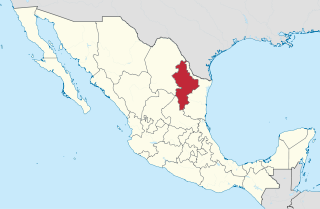
Nuevo León is a state in the northeast region of Mexico. The state was named after the New Kingdom of León, an administrative territory from the Viceroyalty of New Spain, itself was named after the historic Spanish Kingdom of León. With a total land area of 64,555 square kilometers, Nuevo León is the 13th largest federal entity in Mexico. The state is bordered by Tamaulipas to the east, Coahuila to the west, and both Zacatecas and San Luis Potosi to the south. To the north, it shares an extremely narrow international border with the U.S. state of Texas. The Laredo-Colombia Solidarity International Bridge is the only vehicular bridge that connects the United States with the state of Nuevo León. It crosses over the Rio Grande between the city of Colombia, Nuevo León, and Laredo, Texas.

A conurbation is a region comprising a number of metropolises, cities, large towns, and other urban areas which through population growth and physical expansion, have merged to form one continuous urban or industrially developed area. In most cases, a conurbation is a polycentric urbanised area in which transportation has developed to link areas. They create a single urban labour market or travel to work area.
A regional municipality is a type of Canadian municipal government similar to and at the same municipal government level as a county, although the specific structure and servicing responsibilities may vary from place to place. Regional municipalities were formed in highly populated areas where it was considered more efficient to provide certain services, such as water, emergency services, and waste management over an area encompassing more than one local municipality. For this reason, regions may be involved in providing services to residents and businesses.

Filipino Canadians are Canadians of Filipino descent. Filipino Canadians are the fourth largest subgroup of the overseas Filipinos and one of the fastest-growing groups in Canada.

San Nicolás de los Garza, sometimes known only as San Nicolás, is a city and coextensive municipality in the Mexican state of Nuevo León that is part of the Monterrey metropolitan area. It has become primarily a city for residences and family houses, although it still has several factories that tend to relocate to the periphery of the metropolitan area. It is the third-largest city in the state, behind Monterrey and Guadalupe.

A city proper is the geographical area contained within city limits. The term proper is not exclusive to cities; it can describe the geographical area within the boundaries of any given locality. The United Nations defines the term as "the single political jurisdiction which contains the historical city centre."
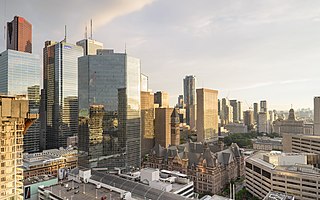
The economy of Toronto is the largest contributor to the Canadian economy, at 20% of national GDP, and an important economic hub of the world. Toronto is a commercial, distribution, financial and industrial centre. It is the banking and stock exchange centre of Canada, and is the country's primary wholesale and distribution point. Ontario's wealth of raw materials and hydroelectric power have made Toronto a primary centre of industry. The metropolitan area of Greater Toronto produces more than half of Canada's manufactured goods. The economy of Toronto has had a GDP growth rate of 2.4 percent annually since 2009, outpacing the national average. Toronto's population was 2.93 million people as of 2017, while the population of the Toronto census metropolitan area was 5.92 million as recorded in the 2016 Canadian Census.
The metropolitan areas of Mexico have been traditionally defined as the group of municipalities that heavily interact with each other, usually around a core city. The phenomenon of metropolization in Mexico is relatively recent, starting in the 1940s, and due to the accelerated level of urbanization in the country, the definition of a metropolitan area is reviewed periodically by the Mexican population and census authorities.

Greater San Antonio, officially designated San Antonio–New Braunfels, is an eight-county metropolitan area in the U.S. state of Texas defined by the Office of Management and Budget (OMB). The metropolitan area straddles South Texas and Central Texas and is on the southwestern corner of the Texas Triangle. The official 2020 U.S. census showed the metropolitan area's population at 2,558,143—up from a reported 1,711,103 in 2000—making it the 24th largest metropolitan area in the United States. Austin–Round Rock lies about 80 mi (130 km) northeast of Greater San Antonio.
This is a list of lists of places:

A metropolis is a large city or conurbation which is a significant economic, political, and cultural area for a country or region, and an important hub for regional or international connections, commerce, and communications.

The San Juan metropolitan area is a United States Census Bureau defined metropolitan statistical area (MSA) in northeastern Puerto Rico centered around the city of San Juan. A July 1, 2009, Census Bureau estimate placed the population at 2,617,089, a 4.31% increase over the 2000 census figure of 2,509,007.
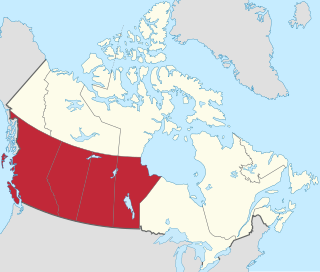
Western Canada, also referred to as the Western provinces, Canadian West or the Western provinces of Canada, and commonly known within Canada as the West, is a Canadian region that includes the four western provinces just north of the Canada–United States border namely British Columbia, Alberta, Saskatchewan and Manitoba. The people of the region are often referred to as "Western Canadians" or "Westerners", and though diverse from province to province are largely seen as being collectively distinct from other Canadians along cultural, linguistic, socioeconomic, geographic, and political lines. They account for approximately 32% of Canada's total population.